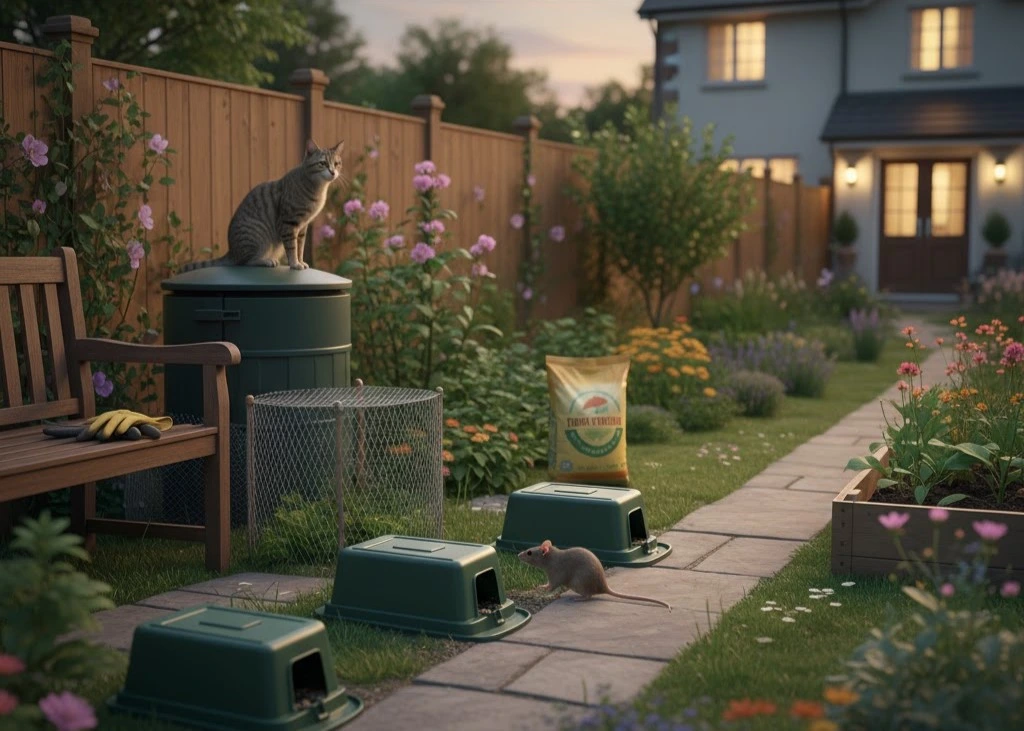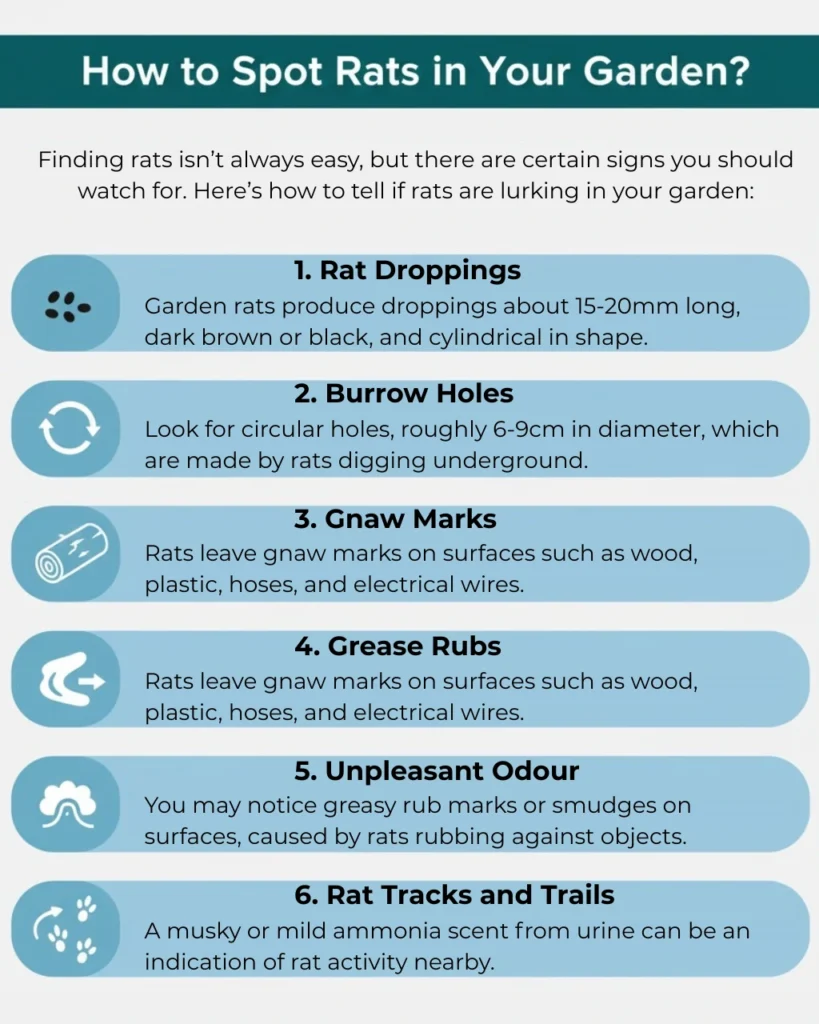Dealing with Norway rats in your garden can be tough. With nearly 150-200 million rats estimated to roam the UK, you’re definitely not the only one looking for ways to eliminate rats from gardens.
Imagine waking up early, planning to enjoy breakfast on your garden bench amid the trees and singing birds. But suddenly, you spot a 20mm cylindrical rat dropping. Your mood shifts from peaceful to anxious in seconds. Your appetite drops, and anxiety starts to creep in.
What should you do? Wait and see if anything happens? Meanwhile, the rats are busy burrowing and multiplying. Instead of giving in to panic, take a deep breath. In this blog, we’ll explore effective ways to control rats in your garden. Ready?
Let’s dive in.
How to Get Rid of Rats in Garden Safely – 14 Proven Ways

Residential rat control can be quite challenging. While garden rats may seem frustrating, the right methods can help you effectively control and eliminate them. Here are 16 proven strategies to help you reclaim your outdoor space:
1. Seal and Manage the Compost to Prevent Rats
Compost piles are a rat’s favorite spot—they act like a warm, inviting hallway. Especially if you add food scraps like bread, meat, grains, or cooked items such as oils or leftovers. Instead, add shrub clippings with thorns or mix food scraps with soil, brown materials, or plant debris to disturb rat nests. If you notice holes, consider flooding them with a hose to discourage rats; they hate their burrows turning into swimming pools.
2. Keep the Yard Exposed and Tidy
Rats often hide under shelters like long grass and shrub branches. An exposed yard reduces hiding spots and helps control rat activity. Regularly trim long grasses, vines, and shrubs. Keep plant pots and vegetable beds away from fences or sheds. Minimize clutter and thick ground covers that provide cover for rats. As an old UK saying goes, you’re never more than 10 feet away from rats in a garden — but with proper maintenance, you can confidently keep them at bay. Always keep your lawn tidy: remove seeds, fallen fruits, and garbage.
3. Block Every Possible Entry Point in the Garden
Rats can enter through openings or climb into your yard. They often nest in compost heaps, beneath decks, sheds, hedgehog houses, or greenhouses. Seal all holes and crevices 5mm or larger in walls, fences, sheds, and other structures. Add an extra metal layer underneath and on the sides for compost bins to prevent burrowing. Keep plastic bins away from climbable surfaces, and bury fence posts at least 6-12 inches deep to prevent rats from climbing over.
4. Handle Bird and Pet Feeding in the Garden Wisely
If not managed properly, birdfeeding can attract rats. To prevent this, use rat-proof baffles on poles and select rat-proof bird feeders. Place feeders in open areas of the garden, at least 6 feet above the ground. Rats dislike exposed, open spaces in the lawn. For pets, always use metal bowls, and clean up any spilled food or leftover pet feed to avoid attracting rodents.
5. Apply Natural Repellents Across the Garden
Essential oils like peppermint, eucalyptus, clove, lavender, and citronella are natural rat repellents. Spray these oils generously over the garden, especially in hidden corners. Vinegar is also effective. Sometimes, sprinkling coffee grounds, cayenne, or chili powder can give additional protection.
6. Secure Trash and Waste in a Tight-Lid Bin
The smell of garbage attracts rats. Manage your waste carefully by using thick, sealed trash bags and placing them in a bin with a tight-fitting lid. Ensure the bin is kept away from your garden and walls to prevent easy access.
7. Clean Off Greasy Marks in the Garden
Greasy smears from rats emit pheromones that signal others to come. When you see these marks, wash them away with vinegar or soap. Missing such signs can lead to increased rat activity and reproduction. Be proactive.
8. Leverage Rats’ Fear of New Things
Norway rats tend to fear anything unfamiliar. Use this to your advantage by frequently changing your garden setup—moving pots, grills, or trimming bushes. Focus on rat pathways and hideouts near walls or sheds.
9. Remove Water Sources from Your Garden
It’s not just about removing food and waste; water sources matter too. Pick up any standing water, repair leaks, and bring pet or bird water dishes inside overnight. Water is a key factor that makes gardens attractive to rats.
10. Let Nature Take Its Course: Encourage Predators
Attracting predators like cats, foxes, raccoons, and birds of prey can naturally reduce rat populations. Remove barriers under decks to allow access, but weigh the potential ecological impacts before encouraging predators into your yard.
11. Community Efforts and Raising Public Awareness
Rats can easily re-infest if food and shelter remain accessible nearby. One yard’s rats can quickly move to the next. Talk to your neighbors, share sightings, and raise awareness about rat issues. A community effort makes a bigger difference than doing it alone.
12. Use an Integrated Pest Management Approach (IPM)
IPM isn’t just about trapping or spraying; it’s about a smart mix of methods—inspection, habitat modification, humane trapping, and chemicals only if necessary. It’s the most effective, responsible way to keep rats out of your garden.
13. Use Lethal Traps or Poison baits to kill rats instantly
If humane rat control isn’t working, it’s time to consider lethal options. The most effective are snap traps, electric shock traps, and poison baits. Select the trap that’s easiest for you to set up. To protect your pets, use tunnel-style poison baits that keep them out of reach.
14. Consider Electric Ultrasonic Rat Repellents
Ultrasonic devices generate high-frequency sounds that rats dislike, helping to keep them away from your garden. Position these repellents near outdoor outlets or in areas where rats are active.

How to Spot Rats in Your Garden?
Finding rats isn’t always easy, but there are certain signs you should watch for. Here’s how to tell if rats are lurking in your garden:
Rat Droppings: Garden rats produce droppings about 15-20mm long, dark brown or black, and cylindrical in shape.
Burrow Holes: Look for circular holes, roughly 6-9cm in diameter, which are made by rats digging underground.
Gnaw Marks: Rats leave gnaw marks on surfaces such as wood, plastic, hoses, and electrical wires.
Grease Rubs: You may notice greasy rub marks or smudges on surfaces, caused by rats rubbing against objects.
Unpleasant Odour: A musky or mild ammonia scent from urine can be an indication of rat activity nearby.
Rat Tracks and Trails: Rats tend to scurry close to walls or edges, often leaving footprints or tracks about 10cm wide. Look for these trail marks on the ground or surfaces.
When to Call Professional Rat Exterminators?
Let’s be honest—garden rat problems usually need professional help eventually. London homeowners often hesitate and are unsure when to call in the pros. Signs that you should consider hiring a professional pest control company include:
- The infestation has become overwhelming and difficult to manage.
- DIY methods have failed after multiple attempts, signaling it’s time for expert assistance.
- There’s evidence of nest sites or burrows that are hard to access or remove without specialized equipment.
- You experience repeated sightings despite previous efforts.
- Rats are seen in multiple areas of the garden or home.
Professionals can accurately assess the issue, find the root cause, and implement lasting solutions.
Bottom Line
Key strategies for eliminating rats in gardens include keeping them tidy, removing food sources, and maintaining good hygiene. Still have queries about how to get rid of rats in gardens? Feel free to contact us with any questions or for further guidance.
FAQ:
What’s the best way to get rid of rats in the garden?
To control rats in your garden, focus on removing their access to food and water, use natural deterrents like peppermint, lavender, or eucalyptus oil, and rearrange your garden layout to minimize hiding spots. Using an Integrated Pest Management approach can also boost effectiveness.
What do rats hate the most?
Rats have a strong aversion to certain scents, including peppermint, lavender, eucalyptus, and citronella oils. They also tend to avoid exposed or open areas where they feel less secure.
Why do rats scream at night?
Since Norway rats are nocturnal, their screams or squeals at night are often signs of stress, fear, or pain—especially if they’re cornered or feeling threatened.
What disease do rats carry?
Rats are known to carry dangerous pathogens such as leptospirosis, hantavirus, and Salmonella. Proper control and hygiene are essential to prevent disease transmission.
Are rats scared of dogs?
Yes, dogs can scare away rats because they are natural predators. Even the sound of barking can make rats retreat from your garden.
Do coffee grounds repel rats?
Indeed, coffee grounds are a popular natural repellent. Sprinkling them around your garden can help keep rats at bay.
